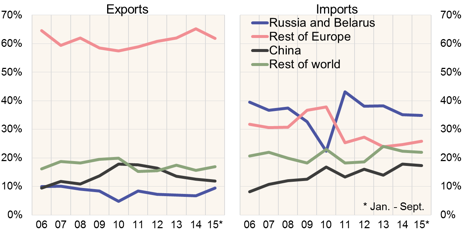BOFIT Weekly Review 49/2015
Impacts of Eurasian Customs and Economic Unions on the Kazakhstan market become clear
Even before Russia, Belarus and Kazakhstan established the Eurasian Customs Union (EACU) and unified their import duties in 2010, tariffs were all but eliminated between CIS countries under free-trade agreements. Thus, the establishment of the EACU affected to a large extent only import duties on goods from non-CIS countries. The weighted average of duties fell slightly in Russia and Belarus, while Kazakhstan’s average rose from just over 5 % to nearly 10 %.
Russia’s WTO accession in 2012 bound it to reducing its import tariffs by 2019. Since then, the EACU states have lowered the external duties according to Russia’s WTO commitments. In Kazakhstan’s case, it remains to be seen what happens. Its WTO agreement came into force this week with even lower tariff bindings than Russia’s.
When the Customs Union became the Eurasian Economic Union (EAEU) at the start of this year, some barriers to market entry were lifted. In Kazakhstan, for example, European emissions standards no longer apply to cars produced within the EAEU. Russia’s share of Kazakhstan’s passenger car imports has increased from less than 10 % in 2010 to over 70 % in the first nine months of this year. Imports of e.g. Russian industrial machinery, televisions and chocolate, as well as Belarus tractors, lorries, meat, and dairy products have increased significantly. At the same time, imports of these products from developed economies have decreased.
Russia’s and Belarus’s share of Kazakhstan’s total imports has not grown, however, because the flow of Chinese products such as clothing, footwear and machinery into Kazakhstan continues to rise. Russia accounted for 33 % of Kazakhstan’s imports in the first nine months of this year ($7.8 billion) and Belarus 1.6 % ($360 million).
Breakdown of Kazakhstan’s goods trade

Sources: Kazakhstan Customs, Eurasian Economic Commission